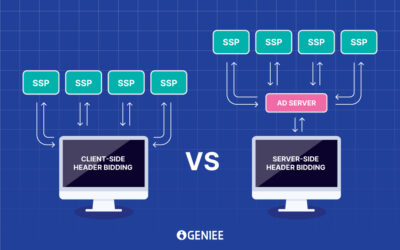
| Our new blog post explains eCPM in detail for publishers. Discover how to calculate it, optimize it, and significantly boost your ad revenue! |
The programmatic advertising landscape has many metrics and models that digital marketers, advertisers, and publishers must fully understand to maximize the potential of their ad revenue.
Among these terms, eCPM is a crucial key performance indicator that, if publishers pay enough attention, can significantly enhance their ad revenue.
At a quick glance, eCPM is a metric that gives publishers valuable insights into the effectiveness of their ad inventory and helps them make data-driven decisions to enhance their content monetization efforts.
To delve deeper into this metric, let’s explore its meaning, calculation, and strategies for optimizing eCPM.
What is eCPM?
eCPM is the abbreviation of Effective Cost Per Mille (eCPM). It’s a metric that represents the estimated earnings per 1,000 ad impressions.
eCPM represents the cumulative revenue generated by publishers per thousand impressions.
However, eCPM is not just limited to impressions; it takes multiple events into account. Have a look.
Users sometimes click these impressions, resulting in leads or conversions to advertising campaigns. Therefore, eCPM is derived not only from CPM campaigns but also from CPC, CPL, and other types of campaigns running through the publisher’s inventory.
By monitoring eCPM frequently, publishers can gain insight into how well ad inventory is performing regarding revenue generation.
Differences between CPM and eCPM
CPM is a fundamental concept that many digital marketers, publishers, and advertisers in the industry are familiar with. It’s a metric indicating the cost for every 1,000 impressions an advertiser is willing to pay.
CPM is primarily concerned with the advertiser’s expenditure, whereas eCPM is a holistic measure encompassing both advertiser spending and publisher earnings.
Let’s look at the table below to see the difference between CPM and eCPM.
| CPM | eCPM |
|---|---|
| CPM stands for Cost Per Mille and represents the cost per 1,000 impressions served or the amount advertisers are willing to pay for 1,000 impressions. | eCPM stands for effective Cost per Mille and represents the ad revenue generated from 1,000 impressions served. |
| Formula for CPM: eCPM=(Total cost of campaign/Total impression)×1000 | Formula for eCPM: eCPM=(Total Earnings/Total Impressions)×1000 |
| CPM is advertiser-side metric | eCPM is publisher-side metric |
A low CPM might seem attractive for advertisers, but if the campaign isn’t generating engagement or conversions, the investment might not be worthwhile.
Conversely, eCPM considers the revenue generated, giving a broader perspective. Focusing solely on CPM can be misleading for publishers, as it doesn’t account for the revenue impact. eCPM bridges this gap, providing a more comprehensive picture of ad’s performance.
More to discover
What is CPM and How to Improve it for better performance

How is eCPM calculated?
As its definition suggests, the eCPM calculation formula consists of 2 components: total revenue and impression.

For instance, if a publisher earns $1000 from 500,000 ad impressions, the eCPM would be:
eCPM=(1000/500,000)×1000=$2
In this example, the site is generating $2 in revenue for every 1,000 ad impressions it gets.
This calculation helps publishers gauge the revenue potential of ad inventory and adjust strategies accordingly.
What is a good eCPM?
Determining a “good” eCPM is subjective and varies across industries, ad formats, geographic locations, and more. Listed below are factors that can constitute eCPM value.
- Industries: Different industries have different average eCPM rates. In the tech industry, eCPM might be higher than in the fashion industry due to different audience engagement levels and advertiser competition.
- Ad formats: Different ad formats (display, video, native, etc.) have different average eCPM rates. Video ads often have a higher eCPM compared to display ads due to their engaging nature.
- Ad Placement: Premium placements often attract higher eCPMs due to increased visibility and engagement. Ads placed above the fold, meaning they are visible without scrolling, typically command higher eCPMs than those below the fold.
- Ad Quality: High-quality, relevant ads can command better eCPMs. Creative elements such as compelling visuals, engaging copy, and clear calls-to-action play a crucial role in capturing audience attention and driving interactions.
- Geographic locations: eCPM rates can vary significantly depending on the region. Traffic from Tier 1 countries like the US, UK, and SP often has higher eCPM rates than traffic from Tier 2 and Tier 3 countries.
- Seasonal Fluctuations: eCPM can fluctuate based on the time of year, with higher rates typically seen during peak advertising seasons, such as the holiday period.
- User engagement: Platforms with highly engaged users often achieve higher eCPMs because advertisers value engaged and responsive audiences more.
Understanding these factors helps publishers optimize monetization strategies for better performance and revenue generation.
Read more – Online Advertising tiers
How does eCPM reflect income?
For publishers, eCPM is directly tied to income. Higher eCPM rates mean that ad impressions are generating more revenue. By optimizing factors like ad placement and ad formats, publishers can boost eCPM, thereby increasing overall earnings.
Monitoring eCPM regularly allows publishers to make data-driven decisions to enhance ad performance and revenue. Publishers can use eCPM as a key performance indicator to assess the effectiveness of their ad strategies.
Moreover, by analyzing eCPM trends, publishers can identify which placements, formats, and targeting options yield the best results and adjust their approach accordingly.
Additionally, understanding the factors that influence eCPM enables publishers to experiment with different variables and find the optimal combination that maximizes revenue.
Strategies to Optimize eCPM Performance
Optimizing eCPM can be challenging, as there’s no certainty that you will earn the amount predicted by your eCPM calculation. However, there are proactive steps publishers can take to enhance ad inventory’s performance. The effectiveness will vary depending on the publisher’s context and specific ad monetization approach.
Increase Monthly Traffic
Higher traffic volume can enhance revenue potential. More traffic means more ad impressions, which can directly increase earnings.
To achieve this, focus on a robust content strategy that delivers valuable and engaging content consistently.
By focusing on expanding your website’s reach, you establish a solid foundation for maximizing your earnings in partnership with ad networks and advertisers.
Partner with Multiple Ad Networks
Adding multiple ad networks diversifies your ad revenue streams. Offering your ad inventory to varied ad networks brings in increased competition on ad units, ultimately increasing your revenue and eCPM value.
When joining an ad network, remember to do research to find networks offering better deals for different geographical locations.
Try different ad formats and types
As mentioned, ad formats are one of the factors affecting the value of eCPM. Depending on website content or engagement nature, publishers can choose to monetize from different ad formats like display ads, text ads, video ads, or native ads. From these ad formats, each ad network also develops its own ad types to optimize the revenue potential for publishers.
Run tests on various ad formats and analyze the performance regularly to discover the best combinations that maximize eCPM and overall ad revenue.
More to discover
All About Video Ads: Formats, Setup & Benefits for Publishers

Improve your user experience
Enhancing user experience is critical for increasing ad engagement and revenue. A positive user experience encourages longer visits and a higher ad interaction rate.
Improve page load speeds to reduce bounce rates and ensure that ads are strategically placed to be visible without disrupting the user’s experience.
By prioritizing user experience, publishers can foster a loyal audience and increase eCPM through higher impression and ad engagement.
Optimize your site for SEO
Implement effective SEO practices to get more users landing on your page. Organic search users are high-quality traffic because they arrive at a website after actively searching for specific information or content through a search engine. Their intent-driven behavior makes them more likely to engage with both content and ads, leading to higher interaction rates.
By focusing on optimizing for SEO and attracting organic search traffic, publishers can effectively boost eCPM value and overall ad revenue potential.
Enhance Ad viewability
Ads are ineffective if users don’t see them. Hence, ad viewability has become a crucial metric for advertisers when purchasing inventory. To combat banner blindness and maximize ad effectiveness, we advise publishers to prioritize improving your viewability scores. This involves ensuring that ads are placed where they are more likely to be seen and interacted with, thereby increasing engagement and potentially boosting revenue for publishers.
Ensure your website is mobile-friendly
A responsive design that adapts seamlessly to different screen sizes and devices improves user experience and engagement.
By prioritizing mobile optimization, publishers can capitalize on the growing mobile audience, enhance user experience, and increase ad revenue through improved ad visibility and engagement on mobile devices.
By implementing these strategies thoughtfully and adapting them to fit your specific audience and content, publishers can work towards maximizing your eCPM and overall ad revenue.
Leverage eCPM in Revenue Analysis and Optimization
eCPM allows publishers to know how much money is generated for every thousand ad impressions served. Following that, publishers can assess the effectiveness of their ads and overall content monetization strategies.
By leveraging eCPM data, publishers can standardize their revenue rates and compare ad earnings across various factors such as geography, ad network, device type, and ad unit.
Unlike total revenue figures, eCPM provides a calculated rate that allows publishers to identify top-performing ad units, formats, target audiences, or ad networks, even if they don’t generate the highest total revenue.
This insight enables publishers to optimize their ad placements and strategies more effectively to maximize overall revenue potential.
Final words
eCPM, along with other metrics like CPM, is a vital metric publishers should know about in their content monetization business.
Understanding eCPM and its influence on ad revenue enables publishers to maximize their revenue potential and create a more comprehensive content monetization strategy.
If you’re generating over $1,000 in monthly ad revenue, contact us today to discover how Geniee can help boost your earnings and optimize the ad space on your content platforms.
FAQ
1. What is eCPM?
eCPM stands for effective cost per 1,000 impressions or effective cost per mille. This is a key metric for publishers to determine the earning potential of 1,000 ad impressions.
2. How is eCPM calculated?
The formula of eCPM is:
eCPM=(Total Impressions/Total Earnings)×1000
3. Why is my eCPM low?
If you’re seeing a low eCPM on your website, the first thing to consider is a competition shortage. Look again at the ad networks you are working with and consider joining more to increase the competition. Other factors also affecting your eCPM include content quality, geographical traffic sources, ad formats, ad placements, and more.
Look at your data and analyze these factors to identify the problem and refine your strategy for an increased eCPM.




0 Comments